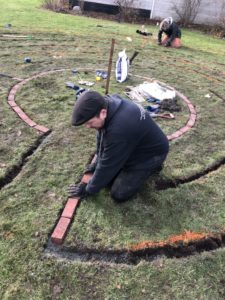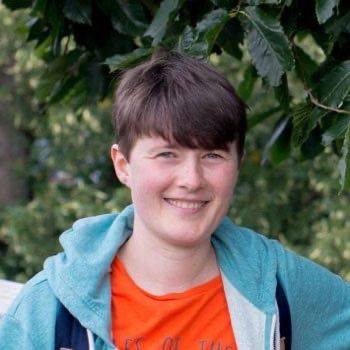While you might associate images of twisting labyrinthine patterns with pagan and Celtic spirituality, labyrinths have had a presence in Christian spirituality since at least the fourth century. The most well-known example of a Christian labyrinth is in Chartres Cathedral, which dates from the early 13th century. At that time, pilgrimage was an important part of Christian spirituality and labyrinths offered a form of internal pilgrimage. Many labyrinths have an entry stone where “pilgrims” can state their intention. Walking the twisting pathways offers an opportunity for prayer and reflection.
Victoria is already home to several labyrinths. There is one at Christ Church Cathedral, which was designed and built by inmates from the William Head Institution, and another at St Philip, Oak Bay. Now, the church communities of St Matthias and the AbbeyChurch, which share a site along with the Emmaus Community at 600 Richmond Ave, are adding to this list with a labyrinth of their own.
The seeds for the labyrinth were planted during the last few years when, as a response to the COVID-19 restrictions on in-person worship, the churches created spirals of stations on an area of lawn next to the sidewalk for Advent 2020 and Lent 2021. Since the lawn is accessible from the sidewalk, many people from the neighbourhood walked the stations and expressed their appreciation.
“It showed that people wanted this embodied, outdoor spiritual experience, even when the Christian messages didn’t necessarily resonate with them,” says Rob Crosby-Shearer, a leader with the Emmaus Community and the AbbeyChurch and a friend of St Matthias.
When the churches were approached by the Greater Victoria Placemaking Network (GVPN) about partnering, the groundwork had already been laid. GVPN’s mission is “to inspire people, neighbourhoods and communities to create vibrant public places that promote health, happiness and well-being.” One of its initiatives has been to map all the “little free libraries” that will be familiar to many Victoria residents. GVPN visited the site and helped the churches dream up a vision for an accessible outdoor community space. It also supported the churches in applying for funding from the City of Victoria’s My Great Neighbourhood Grant program, which allowed work on the labyrinth — just one element of their vision — to commence.

Rob and some of the other clergy had previous experience building labyrinths. With a simple and traditional design in mind, and a group of volunteers ranging in age from six to 80, the churches set to work in the fall last year. For Rob, it was a positive experience.
“It was a great way for the two churches to come together,” he says. “Planning out the labyrinth was fun. It took a lot of figuring out. It’s still a work in progress, we still need to add the brick edging and we’re working on signage to explain the universal and Christian significance of labyrinths. We may also plant something in the middle, perhaps a hazelnut tree as a nod to St Julian of Norwich, who saw the universe in a hazelnut.”
Speaking to the placemaking aspect of the project, Rob emphasized that place has always been an important part of the Anglican tradition.
“The parish as a land-based neighbourhood has always been part of the Anglican tradition, part of the Anglican consciousness — ‘this is my parish, my space,’” Rob says. “It’s a space that transcends religious affiliation.”
So, while the project was originally inspired by the necessity of moving worship and contemplation outside of church buildings due to the pandemic, it is also very much rooted in place.
Other plans for the area include planting native plants and providing seating and accessible picnic tables. St Matthias also has an enclosed outdoor area, which it hopes to make more welcoming to the wider community.
“It will be neat to see how it evolves,” says Rob. “Pathways are formed by the way people naturally gravitate and that’s one of the principles we used. We’re following the path that’s being set by others.”




